Millions of store chickens suffer burns from excrement
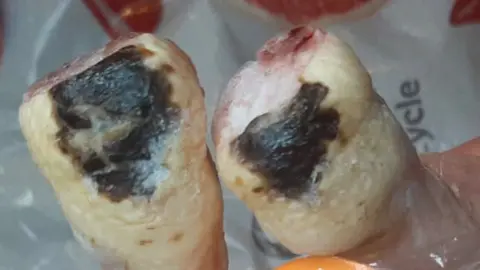 BBC
BBCMillions of supermarket chickens show skin burns from living in their own waste, a BBC investigation has found.
"Hock burn" is caused by ammonia from excrement. A sign of poorer welfare on farms, it can be seen on a third of birds in some supermarkets, data shows.
The BBC asked the 10 biggest UK chains about its presence on their shelves. Co-op and Aldi reported the highest rates but five refused to release data.
The British Retail Consortium said the issue was taken "very seriously".
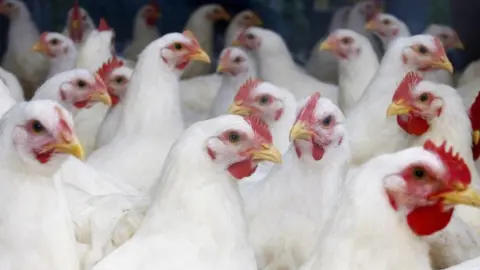 Getty Images
Getty ImagesHock burn is often associated with a high-stocking density of birds and is a result of prolonged contact to moist, dirty litter. It shows up on packaged and prepared meat as brown ulcers on the back of the leg.
Chicken with hock burn markings is still safe to eat. But the amount of hock burn within a poultry flock is an industry-accepted indicator of wider welfare standards on farms.
Red Tractor, the UK's biggest farm and food assurance scheme, sets a target rate for hock burn of no more than 15% of a flock.
A spokesperson for Co-op said that "every effort" was made to minimise the occurrence of hock burn, also known as hock marking.
An Aldi spokesperson added it that it worked closely with suppliers to "ensure continuous improvement in our food… products".
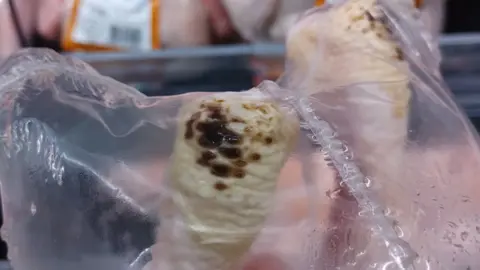 Open Cages
Open CagesKate Parkes, poultry specialist at the RSPCA, told the BBC that hock burn was "a concerning health issue and, sadly, too common in many intensive farm settings".
She added that the risk of hock burn "is significantly higher when birds are poorly managed, genetically selected to grow very fast or reared in overcrowded conditions".
While Lidl was one of the stores that did not provide data to the BBC, it has been the focus of store spot checks by one animal welfare campaign group, Open Cages.
It asked volunteers to check more than 500 whole chickens on shelves at 22 Lidl stores in nine UK towns and cities between September and November last year.
Including any sign of hock burn ulcers at all, it says their shoppers found 74% of the chickens they checked had the condition.
Connor Jackson, co-founder of the campaign group, said hock burn was "one symptom of a much larger problem".
He added that many retailers "source chickens raised in heavily-crowded sheds, bred for extremely rapid growth, and this is routinely causing chickens immense suffering".
Lidl is now being urged to sign up to the Better Chicken Commitment (BCC), a set of RSPCA-backed higher welfare standards for the industry.
Health 'closely monitored'
A spokesperson for Lidl said the total number of chicken products that Open Cages said it had checked in its survey was a tiny percentage of the fresh chicken it sold in that period.
He added: "The figures provided by Open Cages strongly conflict with our own data, which is lower than industry figures publicly available."
The company declined to share its actual hock burn figures but said it had plans in place to publish a full and detailed animal welfare report soon.
"We take animal welfare extremely seriously, and the health of animals in our supply chain is closely monitored, with regular independent audits carried out to ensure that expected standards are being met," he said.
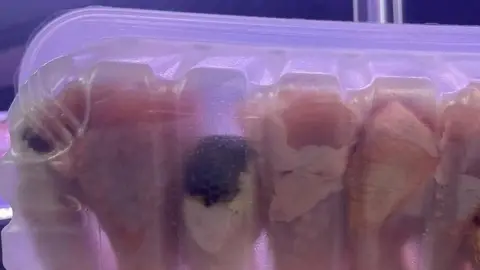 Open Cages
Open CagesThe British Poultry Council, which represents suppliers, processors and farmers, added that "drawing comparison between formal inspection and rigorous procedure versus a shop-shelf experiment has potential to mislead and misinform".
It added that where hock-marking does occur "it is used as an indicator to identify areas for improvement because ours is an industry that operates to science-based standards, prioritises investment in research and development, and keeps pace with innovation".
The BBC requested animal welfare data from 10 leading UK food sellers: Tesco, Sainsbury's, Asda, Morrisons, Aldi, Co-op, Lidl, Waitrose, Iceland and Ocado.
Five of the companies - Asda, Morrisons, Lidl, Iceland and Ocado - failed to provide specific figures.
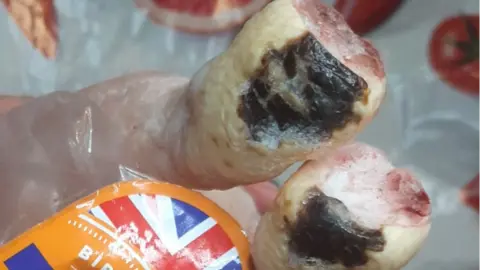 Open Cages
Open CagesOf the remaining five, Co-op, which is supplied with an estimated 30 million chickens a year, recorded hock burn in 36.7% of its poultry.
A spokesperson for the company said: "We work with our supplier to make every effort to minimise the occurrence of hock markings."
She added that the company had this month moved to using lower stocking density birds "which will have a significant positive impact on the reduction of hock markings, amongst other welfare benefits".
Aldi's most recent annual figures revealed it had found hock burn in 33.5% of its chickens.
An Aldi spokesperson said it recorded and published welfare data to "ensure transparency".
"We take animal welfare extremely seriously and work closely with our suppliers to ensure continuous improvement in our food and non-food products."
'Significant step' taken
Company animal welfare reports reveal Tesco recorded a 26.3% rate in its chickens in 2022/23. The company declined to comment formally but said its data included any sign of hock burn, no matter how small, which its competitors might not record.
Sainsbury's, which found hock burn in one in five of its chickens, said it was "very open about the progress we are making in our annual health and welfare reports and last year took a significant step by moving all of our by Sainsbury's chickens to have 20% more space than the industry standard".
Waitrose had the lowest recorded annual figure of 2.7%. It told the BBC it has reduced hock marking levels by 80% between 2014 and 2022 by closely monitoring environmental conditions on farms and training farmers.
"Today, the overwhelming majority of our birds are free of any hock marking, and it's our ambition to make hock burn a thing of the past," a spokeswoman said.
Andrew Opie, director of food and sustainability at the British Retail Consortium, said: "Our members take their responsibilities to animal welfare very seriously, and expect high standards, independently audited, from all of their suppliers.
"They are committed to continuously improving the quality and welfare standards of their ranges."
The UK government's code of practice for the welfare of meat chickens - or broilers - says the health and welfare of poultry is directly linked to litter quality and "conditions such as hock burn… are usually consequences of poor litter quality."
A Defra spokesperson said current animal welfare legislation requires that all chickens must have permanent access to dry litter to ensure their health and welfare and that "breaches of legislation (are) taken very seriously."
The NFU said UK farmers had "some of the highest animal welfare standards in the world" and used well-ventilated barns to prevent wet bedding and hay bales and perches to encourage their birds to move around to prevent hock burn.
